
copyright 2007 by George Johnson
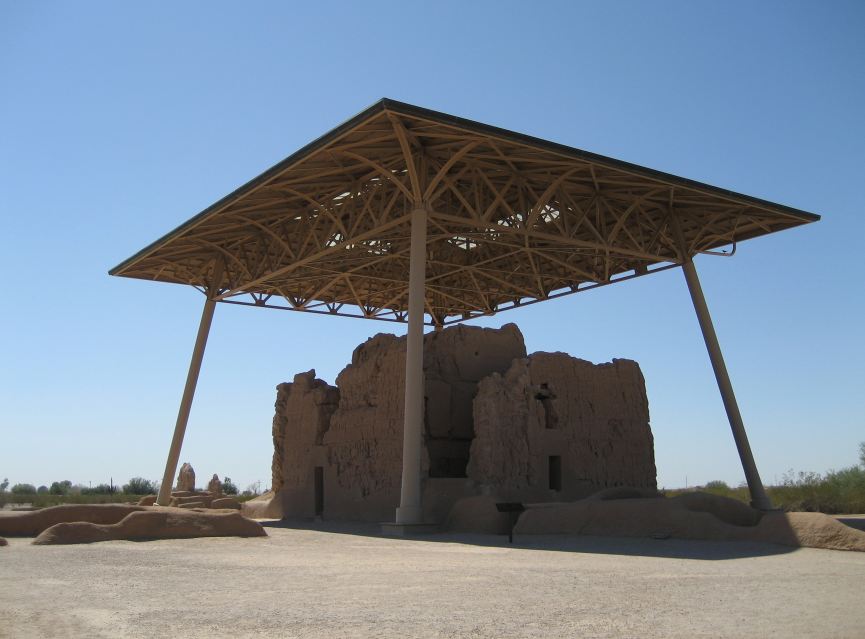
Casa Grande National Monument, Arizona, photo by George Johnson, copyright 2007
1. Retrofit Arithmetic (and Rainbarrel Economics)
2. The San Juan-Chama Shell Game
3. The Case of the Disappearing Aquifer
4. The Creative Hydrology of Suerte del Sur
5. The City, the County, and a Water Tax Revolt
6. Water Numerology at City Hall
(Our story thus far)
7. The Woman at Otowi Gauge
8. "Forget it, Jake. It's Chinatown."
9. The Las Campanas Connection
(Our story continues)
10. The Engineering Solution
November 12, 2007
46. The Battle for Talaya Hill
One morning last week as I was walking out the door, I noticed the chimney of Tom Ford's new mansion peeking through the trees. After all the years of legal wrangling and politicking by the site's various owners, the column of cinderblocks (you can see it when the light is right through the Tom Ford Webcam) is like a flag announcing to the citizens in the lands below that Talaya Hill, if that is what it's called, has been successfully occupied.
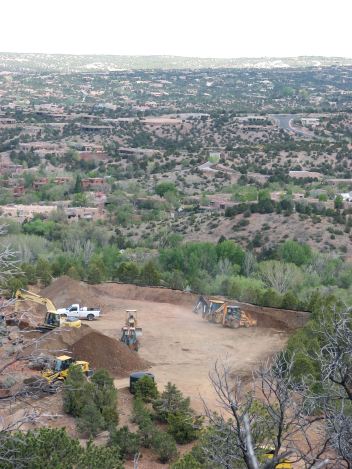
I've written here before about the geographical confusion, which dates as far back as the 1890s when the old Talaya Hill Grant was adjudicated in the United States Court of Private Land Claims. But whether Talaya is the proper name for this hill or some other, it has now been fully claimed by Mr. Ford.
In the old days there was a reservoir there, fed by a pipe running downhill from upper Santa Fe Canyon. So great was the descent that by the time the water reached Camino Cabra (truly just a goat path then) it had enough head to push its way up to the hilltop, filling an open pool. The reservoir fed an acequia, and one of my neighbors, Ricardo Tafoya, once told me that the water was used not only to irrigate the small fields and orchards but also to make the adobe bricks for the Church of Cristo Rey. His brother, Eduardo, who also lived nearby, remembered ice skating on the reservoir pond when he was a boy. During the holidays, he told me, the hill was lit by an electric Christmas star. Both men are gone now and the neighborhood is poorer without them.
In a better world, those 10 acres with their panoramic view -- the best in town -- might have become open space when the city acquired the Sangre de Cristo Water Company (a division of PNM) in the mid 1990s. But the choice piece of real estate had already been sold to Julian Garcia, an Albuquerque car dealer. He sold it to Gerald Peters, who cut a deal with a staffer at city hall -- with no public hearing or consideration by a single elected official -- granting him an exception to the escarpment ordinance, which forbids building on hilltops. In return Mr. Peters agreed not to subdivide the land.
Maybe he anticipated the outrage that would ensue if he carried through with the plan. (Shirley Maclaine had recently been chased off Atalaya Mountain.) Through a partnership, he sold the site to a New York financier named Paul Tierney, who announced his intentions to build a 12,000 square-foot estate.
I still remember the meeting in late 1995 or early 1996 at Santa Fe Prep where Mr. Tierney's builder and representative, Sharon Woods (coauthor of the Santa Style coffee-table book and then, as now, chairman of the Historic Design Review Board) presented the proposal to the neighborhood. Some of us thought at first that the trade-off might be worth it: one gargantuan residence on 10 acres instead of several less obtrusive ones. But when neighbors began asking pointed questions, Ms. Woods and her people summarily called the meeting to an end, rolled up their blueprints, and stalked away.
If she had been scrapping for a fight, she got one. The recently formed San Acacio Neighborhood Association appealed the request for a building permit, and the City Attorney ultimately ruled that the waiver to the ridgetop rules had been improperly granted. Relying on that opinion, the City Council sided with the neighborhood association and asked the Tierneys to build elsewhere on their lot.
Instead they sued, drawing national attention when they claimed under the Civil Rights Act of 1871 that they had been discriminated against -- as wealthy Easterners. The city put up a half-hearted defense but its case had been weakened by procedural issues and some intemperate public remarks by Mayor Jaramillo about outsiders who "don't fit in." Pressured by its insurance company to settle, the city paid the Tierneys $300,000 and agreed not to stand in their way. The neighborhood association lost its own appeal and, after finally prevailing, Mr. Tierney decided he didn't want to live on the hill after all. Years later he sold it to Mr. Ford.
The rest of the story has been recounted here in bits and pieces. (Please see The Environmenal Impact of Jennifer Jenkins and The Sorrows of San Acacio.) Having been ground down by Mr. Tierney, not many people could muster the spirit for another fight. That and Mr. Ford's willingness to meet with neighbors and negotiate bought him his spot on top of Mr. Tafoya's old skating pond.
After a summer and fall of beeping backhoes and the scraping of metal against rock, it is almost a relief to see the project go vertical. Another year and maybe it will be done.

November 18, 2007
The Santa Fe Neighborhood Law Center
Last month in what may lead to a realignment in the Santa Fe power structure, attorneys Fred Rowe and Daniel Yohalem announced the establishment of the Santa Fe Neighborhood Law Center. As Mr. Rowe wrote in a column in this morning's New Mexican:
Our guiding rationale is that Santa Fe's regulatory process inherently tilts toward developers with resources for hiring lawyers and experts, who can roll over resistance by neighbors who lack professional skills or representation. Because of this imbalance, neighborhoods suffer from denser developments, taller buildings, shorter rentals and faster dollars.
Their hope is to tip the scales the other way.
Mr. Rowe, who moved to Santa Fe after working for years in Washington as a corporate lawyer, has become a veteran of the local land and water wars. In the mid 1990s after he and his northside neighborhood association succeeded in stopping the planned Los Vecinos subdivision because of drainage issues, he was a target of a SLAPP suit filed by the developers' lawyer, Karl Sommer. The acronym means "strategic lawsuit against public participation" -- a mechanism for silencing members of the public who stand in the way of the developers' plans. Ultimately Mr. Rowe prevailed and was instrumental in the passage of a state law against SLAPP suits. He also won a landmark decision in federal appeals court making clear that what the city land use code stipulates are simply minimum requirements. As an elected governing body responsible for guiding the city's future, the Council has the power to hold a proposed development to higher standards in the interest of the common good.
Mr. Yohalem, the other partner in this new effort, is a force of his own. After serving as head of the Civil Division of the New Mexico State Attorney General's Office and president of the New Mexico Foundation for Open Government (where he is still a director), he represented the Canyon Neighborhood Association in its fight against the Fred Klein driveway.
One Saturday in November 2001, Mr. Klein had bladed a 2,400-foot-long roadway across city land to reach a parcel he was developing adjacent to the Cerros Colorados subdivision. In a case that moved from the Planning Commission to the City Council and finally to District Court, Mr. Yohalem successfully argued that the easement Mr. Klein had relied on was improper. Had the case gone the other way, residents feared that Cerro Gordo Road might have eventually become connected to Hyde Park Road, funneling more traffic onto already overburdened streets.
As their first order of business Mr. Rowe and Mr. Yohalem have taken the side of the neighborhoods in the short-term rental fight -- a welcome counterbalance to the management companies, which are already threatening to sue if they don't get their way. I'll be writing more about the law center's proposal in coming days.
November 26, 2007
I was disappointed at first that the Neighborhood Law Center's plan to phase out illegal vacation rentals is weaker than the one Mayor Coss and Councilor Chavez introduced last month. The earlier bill would have allowed violators in business as of 2002 to continue for five more years to "amortize" their investment. Under the Neighborhood Law Center's proposal, drafted by Mr. Rowe and Mr. Yohalem, this amnesty would be expanded to include everyone operating up until the moment the new ordinance is passed.
This is their reasoning: Though short-term rentals have arguably been illegal since 1987 and doubtlessly so since 2002, City Hall's failure to enforce the law has left it in a weakened position. Adding to the uncertainty is whether the 2002 changes were properly advertised. So unless the city is prepared to endure years of complex litigation, it must hold its nose and give all the scofflaws the benefit of the doubt. After all, five more years and they will be gone.
It's galling that the purveyor of an illegal enterprise would claim a vested property right and then construe its truncation as a "taking" under the Constitution of the United States. But that is the kind of world we live in. I would love to see the city go to the mat on this, defending what every speaker of the English language knows: that a residential neighborhood is where people reside.
The sad truth is that the city has an unimpressive history of sustaining litigation. As with the Tierney case, it might succumb to pressure from its insurers (or attention deficit disorder) and drop the ball.
Given all that, what the Neighborhood Law Center has suggested is probably the wisest course: passage of a bullet-proof bill that will finally put an end to this blight.
November 30, 2007
In a well-crafted story in today's New Mexican (with a particularly punchy final paragraph), Jason Auslander describes another case that has been thrown out of court because of the incompetence of the Santa Fe Police Department. Though the suspect was arrested more than a year and a half ago, the police didn't bother sending the evidence -- 11 grams of cocaine -- to the state crime lab until last week. And when they did, some of it was missing. As though that weren't bad enough, neither of the subpoenaed officers showed up for the trial. One was out sick and the other was on "family medical leave." Police Chief Eric Johnson made the usual excuses. No wonder crime is on the rise here. It really does pay.
December 2, 2007
One of the weirder spectacles this year at City Hall was the snow job that Kurt Young (please click here for background on the young entrepreneur) and a company called Safe Property LLC laid on the Council at a meeting last spring. By cynically playing the affordable housing card, Mr. Young and his associates managed to get a two-acre residential lot rezoned to squeeze in a 19-unit condominium complex. The details are in my posting of May 10.
Since then the Vista Encantada Neighborhood Association has appealed, and now the Old Santa Fe Association, represented by the Neighborhood Law Center (please see my earlier postings on this page) has asked to join in the action. In their District Court filing, the plaintiffs describe the council's decision as "a textbook case of unlawful spot zoning" -- defined as "singling out by a zoning amendment a small parcel of land for the benefit of one developer." Moreover, the motion notes, the council ignored the safety and health issues involved with perching so dense a development on a precipitous slope next to a freeway interchange.
"This was a case of affordable housing being used to justify bad development," Fred Rowe of the Neighborhood Law Center told the Journal. "If you can get by with doing that once, the signal is all you have to do is include a few affordable-housing units and your project will be approved."
Meanwhile efforts continue to cram multi-story apartment buildings into a modest neighborhood of single-family houses along Juanita Street. (The "Stylish New Railyard Area Condos" with "Sexy Designer Finishes" are advertised on page five of the current Santa Fe Real Estate Guide and are being marketed by Sotheby's.) As noted in an editorial in today's Journal, City Councilors resolved six years ago to down-zone the area to preserve its small-scale character. But apparently they forgot.
Though it is too late for Juanita Street, the growing resentment over this and other abuses has led Councilor Heldmeyer to propose a Neighborhood Conservation District Ordinance, which might extend some of the protections now afforded to the more affluent historic districts. The Chamber of Commerce, of course, hates the idea, holding to its theory that the only consideration guiding urban planning should be the profitability of its members.


Santa Fe's Dying River Plan (cont.)
December 6, 2007
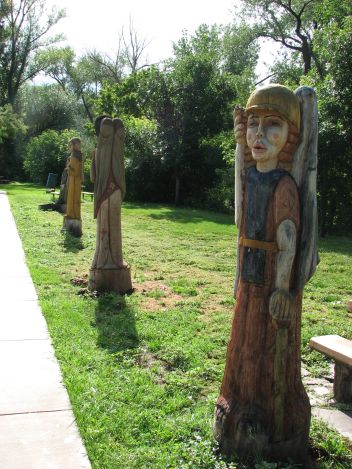
In retrospect one of the worst things to happen to the dead, dry Santa Fe River was the upgrade of the water treatment plant on upper Canyon Road. With the increased capacity, the city has come to rely more heavily on the reservoirs than ever. Here is a comparison between this year and last of water use (measured in acre-feet) through the end of November:
| 2006 | 2007 | |
|---|---|---|
| Buckman Wells | 4906.57 | 3418.23 | City Wells | 2320.72 | 1151.59 | Santa Fe River | 1760.89 | 4707.74 |
The well fields are being given a needed rest -- but it comes at the expense of the river. (Please see here and here for the raw data.) Next spring we'll know how severe the damage is. It has been too warm for the cottonwoods to go into dormancy, yet they are being starved of water -- a perfect combination for killing trees. Look for more chainsaw sculptures along the Alameda in place of shade.
In a recent piece in The New Mexican, Staci Matlock tells us that the city will present more than 30 ideas for reviving the river at a Town Hall meeting on Saturday. We can only hope to hear some fresh thinking instead of the usual stuff-that-will-never-happen (expending fossil fuels to pump treated effluent 12 miles and 1,000 feet uphill and letting it run back down again) or platitudes about conservation. As Ms. Matlock points out, Santa Feans are already conserving. The problem is unrestrained development and the boom-or-bust river mismanagement plan that has been described here many times before:
The way to conserve water and let the river flow is to stop building more hotels and more houses -- there is a glut of those on the market already -- and to stop approving every lot split and condo project that comes along. (For some biting comments about the city's failure on that front, please see today's letter page of the New Mexican.)
December 9, 2007
It was puzzling at first to read in Friday's New Mexican that Mayor Coss has postponed this week's hearing on the proposed short-term rental ordinance until January "so more city councilors can participate."
Coss said he's been polling councilors to see where they stand, and if some members are absent -- as Councilor Ron Trujillo plans to be -- the measure has little chance of passing. The mayor also said he didn't want to break a tie on the issue because he wanted the council to agree.
The hint that Councilor Trujillo might support Mr. Coss's bill, which would phase out illegal rentals over the next five years, was a welcome surprise. But either way the votes seemed to be there. Councilors Karen Heldmeyer, Patti Bushee, and Chris Calvert, who represent the districts where the problem is worst, would probably vote for the measure. Add in the two cosponsors, Councilors Miguel Chavez and Rebecca Wurzburger, and you would have a majority. So why not get on with the vote?
The resolution to the mystery is buried in a news brief this morning: Councilor Wurzburger has jumped ship.
It had been heartening to think that Ms. Wurzburger, the real estate industry's de facto representative on the council, had seen the wisdom of the compromise: Her good friend Janet Rousselot (owner of The Management Group) would have five years to retool her business, while constituents whose neighborhoods have been illegally commercialized could focus on the light at the end of the tunnel. Now all is in darkness again.

There was more bad news today. With some allies on the Planning Commission, developers are launching an assault on the law against building mansions on ridgetops. So much to write about and so little time . . .
December 11, 2007
Santa Fe's Wild Cat Problem
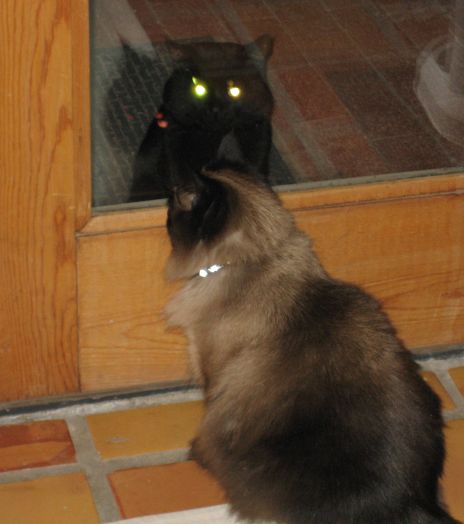
Sometime in the past, a few Himalayan, Persian, and Siamese cats must have wandered off from their Eastside homes -- and for the last 15 years the offspring have regularly appeared here at the backdoor. Our yard is one of the few dog-free zones in the neighborhood, and word soon got out that it's a good place to get a handout.
We've adopted a couple of these beautiful animals -- people can hardly believe they are strays -- and had them neutered. But as their young cousins came around looking for a place to crash, I began capturing them in a live animal trap and taking them to the shelter. There was said to be a shortage of kittens then, so it seemed likely that these would be adopted.
I don't know what to do now. Last week Anne Constable reported in the New Mexican that Santa Fe's shelters are overflowing. If I bring in the sleek black cat with green eyes that has started hanging around, it would probably be exterminated.
I mentioned the San Acacio cats three days ago on bloggingheads.tv, a garish-green postmodern website where my colleague John Horgan and I meet most Saturdays to talk about science. The occasion was a recent piece in the New York Times Sunday Magazine about a Texas birdwatcher who was arrested for shooting and killing a cat that was stalking wild birds near a bridge by Galveston Bay. A tollbooth attendant, who had adopted the cat as a pet, called the police.
The line was drawn. John, whose wife, Suzie Gilbert, runs a nonprofit in the Hudson Valley that rehabilitates injured birds, considered the gunman a hero. I thought he'd acted like a jerk. There are other ways than vigilantism to deal with this complex situation. It is true that the cats, acting by instinct, are an invasive species. But so are the people whose own population explosion is what has destroyed so much bird habitat.
I also disagreed with John that every pet cat, without exception, should be kept indoors for every moment of its life. Suzie was aghast. Here is her reaction:
. . . Most people now realize that they shouldn't dump batteries in the local river or spray their trees with pesticides every summer - why don't these same people realize they shouldn't let their cats out? The idea that a domestic cat's "happiness" is worth hundreds of millions of wild birds a year being ripped to pieces - it just boggles the functioning mind. And doncha just love the outdoor cat people who call themselves "environmentalists" and look down on those who build McMansions and drive Hummers - all the while their pets are taking little bites out of the endangered songbird and shorebird populations? . .
And here is my reply:
I just don't accept that this cat and bird business is so black and white. As I think I said to John during the discussion, our two cats spend most of their time inside, usually in a lethargic (catatonic!) stupor. But when someone opens the door and they catch a whiff of the world, you can almost see their little brains light up. They sample the smells and the sounds as they cautiously proceed onto the patio and, if they're feeling brave, into the yard. It's striking to watch them lock back in sync with their environment, and it's during those times that they seem most alive. So what are the reasons to deny them all that? In seven years the avian death toll has included some English sparrows -- an invasive species that has no more "right" to be here than the cats do -- and [a] poor hummingbird. (I was glad to read that North American hummingbirds are not endangered as are some species in Central and South America. They swarm the hummingbird feeders of Santa Fe -- we got rid of ours -- like wasps.) If the cats wandered much farther, they would quickly encounter their own predators -- coyotes and cars . . .
Ecologists who study predator-prey populations find that they usually go in cycles. I suspect that given time Santa Fe's problem will improve. Meanwhile I admire what Suzie is doing through her organization, Flyaway Inc. But I don't think I'd let her near our cats.
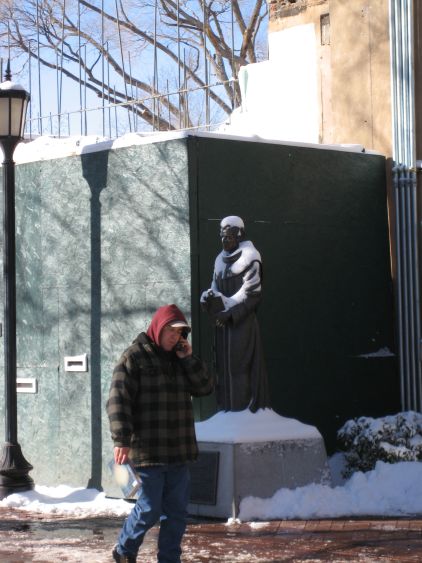
December 23, 2007
Just in the last week the New Mexican has published three outstanding examples of what's known in the trade as "enterprise reporting" -- journalism that digs beneath the surface of the news to reveal fascinating (and sometimes appalling) hidden layers. First was Jason Auslander's excellent dissection last Sunday of the paralysis at Santa Fe's police department that ensued after federal indictments of its two top drug detectives. The story of how police chief Eric Johnson reacted -- suspending narcotics investigations for an entire year (and giving a whole new meaning to the phrase "drug-free zone") -- has been told before, but Mr. Auslander adds some surprising new details.
Next in line was Julie Ann Grimm's revealing piece on the carpetbagging candidacy of Martin Lujan in City Council District 3. One would like to think that a candidate is motivated by a deep concern for problems in his district. But Mr. Lujan, who is expected to find support from the same crowd that brought us Santa Fe Grassroots, doesn't actually live in the city. For appearances' sake, he is renting a house in his opponent Miguel Chavez's neighborhood. But as Ms. Grimm demonstrated by examining the water bills, he can't possibly be living there in any meaningful way.
Finally today we have Phaedra Haywood's fine article on the threat to the Galisteo Basin posed by gas and oil drilling. For weeks I have been hoping and failing to find time to write about what is surely the most important local environmental story of the year. Ms. Haywood does the best job yet of explaining the legacy of "split estate" land deals that leave homeowners with the rights to only the surface of their land. Even worse, she reports, it can be almost impossible to learn who owns the right to dig beneath your feet for minerals and petroleum products.
Also impressive have been Staci Matlock's recent reports on a scheme by New York investors to turn the bone-dry San Agustin Plains into a water mine, pumping 54,000 acre-feet a year to sell to cities like Albuquerque and Santa Fe.
I am always quick to complain about the New Mexican's failings. But I doubt that there is a town this size anywhere else in the country that has such a good daily newspaper.

on to Part 41, Invasion of the Spa People . . .
The Andrew and Sydney Davis Webcam
Santa Fe Review Detours of the Wild West
The Santa Fe Review
More links:
See the current flow of the Santa Fe River above McClure Reservoir with the USGS automated gauge.
The Otowi gauge shows the flow of the Rio Grande north of Santa Fe.
Santa Fe water information, a collection of documents and links